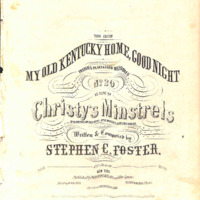Contents
- Broadside Ballads
- George Frederick Root
George Frederick Root
George Frederick Root, who composed under the pen name George Frederick Wurzel, was most prominent for his work within music education and the training of future music educators. In his lifetime he published over 50 different books, both musical compilations and textbooks. Many of his compositions were created for his vocal students including The Trumpet of Reform. These were not limited to solo airs, but also included choral works and cantatas like The Flower Queen. He worked at several different schools instructing voice, including Rutgers Female Institution, Abbot’s School for Young Ladies, and Miss Haine’s School for Young Ladies to name a few. He opened his own school to educate America’s future music educators in 1853 and would continue to influence the progress of music education through his compositions. Although he received acclaim as a composer, he did not begin writing his own compositions until 1850.
In his lifetime Root published over 200 pieces of vocal sheet music. He was greatly influenced by the work of Stephen Foster, taking notes on the format and structure and at times attempting to make his own renditions of Foster’s songs, including The Old Folks are Gone, meant to resemble Old Folks at Home.[1] He composed ‘people’s songs,’ which he loosely defined as music written for the common man.[2] In his autobiography he affirms his belief that the cultivated musical traditions of Europe were not applicable to the American layman. Instead of illustrious orchestration with complex harmonies and embedded subtext that were known to the European upper class, the common American needed a simple, singable melody on a common theme.[3] Often, these ‘people’s songs’ would be written in one key and would use only tonic, dominant, and subdominant chords. Examples of this simplified song style can be seen in Root’s Rosalie the Prairie Flower, The Battle Cry of Freedom, and The Hazel Dell.
Root’s first song to become popular was The Hazel Dell written in 1852 with lyrics that are believed to have been written by Fanny Crosby. The central theme is one of grief, sung by the lover of Nelly who mourns her passing. The idea of grief is carried throughout the entire song, although contrasts with the musical setting. The air and chorus setting is very buoyant, written in the key of G major with moving melodic lines and large leaps of fifths and sevenths throughout. Even given the juxtaposition of text and music The Hazel Dell became quite popular, eventually leading to the parody Fairy Dell. The parody is better suited to the music depicting a secret meeting of two young lovers in the garden at night. The playful and joyous melodies help propel the text Fairy Dell.
| Hazel Dell | Fairy Dell |
|---|---|
|
In the Hazel Dell my Nelly’s sleeping, Chorus: In the Hazel Dell my Nelly’s sleeping, Chorus Now I’m weary, friendless and forsaken, Chorus |
Wilt thou meet me in the fairy dell, love, Chorus: Soon the hour of twilight will be past, love, Chorus I am weary watching here alone, love, Chorus |

